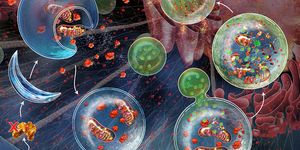Alzheimer’s disease is highly prevalent, accounting for over 7 million new cases every year. While there’s no cure yet, scientists reported that it may be possible to detect and diagnose early stages of the disease from odor signatures in urine. The study was published in the journal
Scientific Reports.

There are currently very limited methods to definitively diagnose Alzheimer’s in living patients. Most tests focus on symptoms of dementia, and the Alzheimer’s diagnosis is only truly confirmed when pathologists find evidence of abnormal amyloid protein clumps in the brain. An odor biomarker could revolutionize how doctors diagnose and treat early stage Alzheimer’s.
The study was performed in mice that were genetically modified to produce the pathological amyloid precursor protein (APP) that’s seen in human patients. The excess production of the toxic proteins also causes impairments in cognition, memory, and behavior in ways that are similar to human patients.
The researchers hypothesized that the APP mice would produce urine with different scents than controls. And this odor can serve as a biomarker to detect early onset Alzheimer’s, even before the toxic protein clumps build up excessively in the brain.
In three separate strains of APP mice, researchers found different chemical and behavioral profiles as compared to control mice. Each APP mouse strain had a distinctly different odor signature than that of control mice. This was confirmed using “sensor” mice that picked up on the abnormal urine scents of APP mice. In addition, the team analyzed the chemical profiles of the urine using gas chromatography / mass spectrometry (GC/MS). This analysis revealed abnormal peaks that correlated to the different strains of APP mice.
The researchers stressed that the distinct odor signatures of the APP mice are not due to the appearance of new chemicals in the urine. Rather, this is due to a shift in the normal concentrations of existing compounds.
"It is always a modulation of the odorants that are present anyway," said Bruce Kimball, a research chemist with the USDA who is stationed at Monell, and the first author of the work. "When some odorants are upregulated and some are down regulated that gives a unique odor change, and the mice pick up on this quite well."
More importantly, the researchers concluded that the APP mice had abnormal urine odors even before they found evidence of amyloid plaques in the brains of these animals. It would seem to suggest that the distinct odor signatures is due to the genetic mutation and not changes in the brain. This is good news for patients who could potentially benefit from knowing their Alzheimer’s diagnosis years before the toxic protein clusters destroy their brain tissues.
But the research is a few years away from being applied to human patients. This study demonstrates great proof-of-principle, but more extensive research has to be done to see if the same odor patterns exist in humans, and whether the odor signatures can be used as an accurate detection tool. With proper funding and research, senior author Daniel Wesson thinks it will take another two years before doctors can use a smell test to diagnose Alzheimer’s in actual patients.
Additional source:
Medical News Today

 There are currently very limited methods to definitively diagnose Alzheimer’s in living patients. Most tests focus on symptoms of dementia, and the Alzheimer’s diagnosis is only truly confirmed when pathologists find evidence of abnormal amyloid protein clumps in the brain. An odor biomarker could revolutionize how doctors diagnose and treat early stage Alzheimer’s.
There are currently very limited methods to definitively diagnose Alzheimer’s in living patients. Most tests focus on symptoms of dementia, and the Alzheimer’s diagnosis is only truly confirmed when pathologists find evidence of abnormal amyloid protein clumps in the brain. An odor biomarker could revolutionize how doctors diagnose and treat early stage Alzheimer’s.







